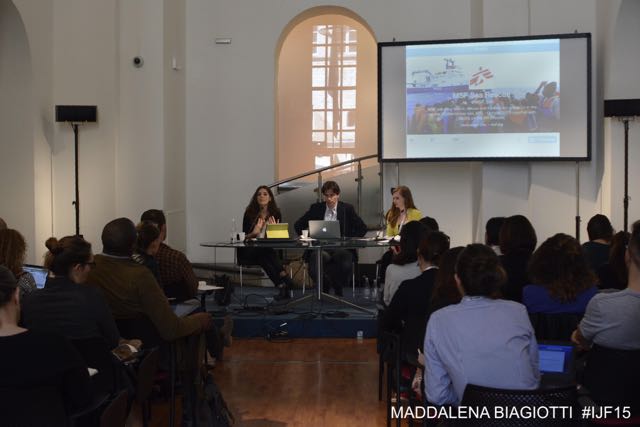
Today around 700 migrants are feared to have drowned, while trying to cross the Mediterranean. But that number alone – seven hundred – does not give the whole picture. It does not tell the story of each man and woman who were in that boat, it does not describe their hopes and dreams, and it does not convey the grim reality faced by those who survived and saw the others drowning.
As this kind of tragedies become more and more common, journalists struggle to find the right words and the right approach to describe them. How can media report on immigration without resorting to sensational headlines, and instead make their readers feel compassion? Should journalists not only tell the facts, but also actively fight against xenophobia? And how can NGOs help media report fairly on immigration?
These questions were addressed on Thursday at the International Journalism Festival in Perugia, during the panel discussion “Let them drown: Activist journalism to counter anti-migrant discourse”, which saw the participation of Herman Grech, Head of Media at The Times of Malta; Maeve Patterson, Head of Communications at Amnesty International European Institutions office in Brussels; and Maria Teresa Sette, a freelance journalist currently working for MOAS, a crowdfunded NGO dedicated to rescuing and saving migrants drowning at sea.
The first problem when reporting on immigration is that there is often confusion about who migrants really are. Often labelled as ‘illegal’, they are depicted as scroungers who come to Europe only to exploit the welfare system, the pannelists said. Right-wing media blame them for spreading diseases, stealing jobs, and bringing the threat of ISIS and terrorism to our doorstep.
Reality, however, is different: “The media is there to report the news and the situation on the ground,” said Patterson. “So they need to report who really is coming: people escaping war, conflict, persecutions, who are looking for a better life in Europe.”
Prejudice and stereotypes are particularly common and cruel in the comment threads on social media, blogs and online articles. After showing several examples of the comments he has to moderate, Grech said that – even if it would be tempting to simply delete or block them – he finds it useful and necessary to engage in a constructive discussion with his readers.
“You would always get diatribe and hatred,” said Grech. “But the bottom line is that we are creating a discussion. If I can impact one or two of the ten readers who are reading me, that’s good enough.”
Engaging with the audience also means not being afraid to speak up and try to actively challenge stereotypes. According to Grech, journalists have the responsibility to take a stance, without giving up their impartiality and objectivity.
“Some people call me pro-migrant,” said Grech. “I am not pro-migrants, but I believe in human rights and I believe that as journalists, sometimes, we need to get out of our comfort zone and assume the role of activists.”
The second main problem is fighting against indifference. As the number of victims keeps growing and tragedies become ordinary, people are increasingly immune to these stories and struggle to feel empathy.
In 2014 alone, almost 3500 people lost their lives crossing the Mediterranean on unseaworthy boats. Each tragedy is followed by the same comments and reactions: the European governments promise that actions will be taken and lessons will be learnt, but no long-term solutions have been proposed and institutions are “absolutely failing the people who are in need of their help,” said Patterson.
With the end of Mare Nostrum, an Italian navy operation that saved the lives of 150,000 migrants, Patterson fears the death toll will only increase. Frontex, the European Union border agency, lacks resources and it is considered inadequate to deal with the scale of the immigration influx forecast for this year.
NGOs are thus left alone to fill the gap. MOAS, launched in 2014, is the first NGO that operates as a search and rescue mission in the Mediterranean. This year it has teamed up with Médecins Sans Frontières (MSF) and in two weeks it will start a new mission at sea. It is a unique project, as generally NGOs focus on helping migrants after they have already reached Europe.
Moreover, MOAS “actively engage with the media in order to change the narrative” and counteract the anti-migrants rhetoric of the right-wing press, Maria Teresa Sette said. MOAS and MSF have decided to create a newsroom on the boat and embed journalists during the mission, to allow them to write first hand accounts on what happens at sea and to see who the migrants really are.
As media and readers start perceiving tragedies as ‘the same old story’, giving voice to the people behind the numbers is indeed one of the best ways to keep immigration in the spotlight.
“It’s not the same old story, because every single one of those people on those boats has their own story,” said Patterson. “Recently I met a young boy who was living in Libya. He got on a boat. He was 15. He had a dream to become a footballer, just like many other boys. But he also had nightmares, because his mother died in the sea. We need to keep giving voice to people like him. We need to give a voice to these voiceless victims.”
Check out the full interview with Patterson here.
And watch the panel discussion below.